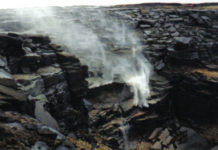As extensive urbanization has resulted in harming the Mother Nature, sooner or later we will have to bear the consequences. The water levels rise each year and an alarming threat looms on the coastal areas of the globe all the time. Historically, apocalyptic events have happened in the past and they will happen again. One such event is associated with the Great Flood in which the entire planet was submerged under water and a man called Noah made it through along with countless species of birds and animals with the help of an Ark which he created. Several books and movies including the latest Russell Crowe starrer ‘Noah’ have depicted the great event. So did the event really take place? If yes, what happened to the Ark which survived the apocalypse?
The Bible says that God warned Noah that he was planning to wipe out Mankind because his sins had grown too much. He told Noah that he wanted to save two of each kind of animal, and Noah and his family, so that Creation could continue after the Great Flood.
Noah was instructed to build a large wooden Ark 45 feet long, 75 feet wide and 45 feet high, which could house and protect them as the waters raged. For 40 days and 40 nights the rain poured and the sea rose until the Earth was completely covered. Both the Bible and the Koran say that the Ark came to rest on Mount Ararat as the water subsided, and that is where the focus of most Ark-hunters attempts has been.
The most common find has been machined and treated timbers, uncovered in areas completely devoid of natural woodland.
The mountain lies in the Far East corner of Turkey close to borders with Russia, Iran and Iraq. The highest peak is just under 17,000 ft high, but the Ark itself is believed to lie a little further down, in a chasm called the Ahora Gorge. In the gorge, there is an ice-covered mountain called Al Judi, which is where the Koran places the beached vessel.
However, this area is not easy to explore and is only accessible for a couple of months each year. Melting ice and rock falls make the Ahora Gorge particularly treacherous, and rolling mists, hidden glaciers and altitude difficulties have ended the research of many adventurers.
Historically it has always been a politically unstable region, close to many of the world’s violent hotspots and the Turkish government has frequently discouraged any organised investigations. The locals themselves are also less than helpful, and one possible resting-place of the ark is said to be guarded by fierce indigenous tribesmen.
..an official Russian military expedition commissioned by the Czar claimed to have found Noah’s Ark..
Despite this, countless researchers searching for the Ark have ventured into the area, and may have discovered proof of a wooden construction locked in the ice caps. The most common find has been machined and treated timbers, uncovered in areas completely devoid of natural woodland. In 1876, a British ambassador to Turkey found such remains when climbing Mount Ararat. The timber he discovered had been hand-hewn and fixed with an extremely hard black covering.
Almost 80 years later, in 1955, an explorer called Fernand Navarra and his son Rafael discovered some wooden beams in a crevice on the mountain. They took samples of the wood and these have been carbon dated as being around 4000 years old. Sightings of the Ark itself have also been documented. The first modern encounter is said to have happened in 1856 what a group of young English atheist scientists climbed the mountain with two local guides.
Despite everyone swearing to keep the discovery secret, two members of the search team independently revealed details on their deathbeds. Around 1910, an official Russian military expedition commissioned by the Czar claimed to have found Noah’s Ark and took measurements and photographs of the vessel. The results and reports sent back to the Czar were all lost or destroyed during the Communist Revolution, but many independent witnesses account for the events that occurred.
The images appear to show the bow of a ship poking out of a glacier.
Crucially, everybody who claims to have found the remains has done so in the same area of Mount Ararat. In more recent years, aerial technology has provided an overall picture of the mountain but has suggested the Ark may lie somewhere different. In 1949, a US Air Force mission photographed an unusual feature 15,500 feet up on the northwestern plateau of Mount Ararat on the other side from the Ahora Gorge.
The images appear to show the bow of a ship poking out of a glacier. The phenomenon was given the name the ‘Ararat Anomaly’ and resurfaced in the 1970s when secret military satellites were able to focus on the area from space.
Since then, more high-powered, clearer and commercial satellites have allowed researchers a better chance of examining the strange structure. It seems to be 600 feet long and some experts believe it may be the wooden ribbed structure of an ancient boat. Other Ark investigators believe it could be simply an old rock formation, an old fortress, or even a crashed aeroplane.
Of course, the only way researchers can gather definite evidence is to be near the site on the ground. But increased tension between Turkey and the area’s Kurdish population has hampered exploration attempts, and the recent instability in nearby Iraq has also added to the region’s pressures.
So far there is no scientific evidence that the Great Flood even took place. Hence, along with that, even the existence of Noah’s Ark is shrouded with mystery.
Until a team of archaeological experts can examine the photographed remains first hand, the mystery of Noah’s Ark will never be solved.
-end-




































